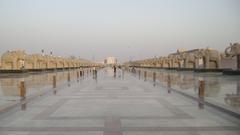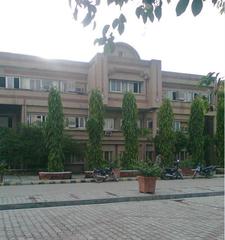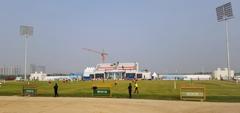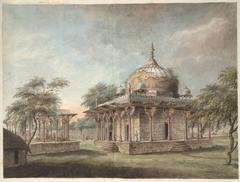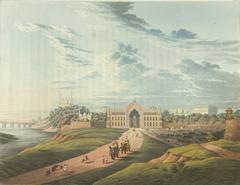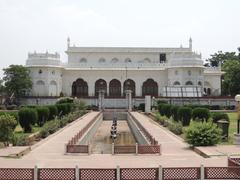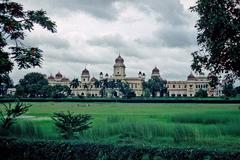
Bara Imambara Lucknow: Visiting Hours, Tickets, and Historical Significance Guide
Date: 03/07/2025
Introduction
Bara Imambara, or Asafi Imambara, is one of Lucknow’s most revered monuments—a masterpiece of Nawabi architecture, cultural significance, and historical depth. Commissioned in 1784 by Nawab Asaf-ud-Daula during a devastating famine, the complex was both a place of worship for Shia Muslims and a large-scale humanitarian project that provided employment to tens of thousands. Today, Bara Imambara stands as a symbol of Lucknow’s rich heritage, attracting travelers, historians, and devotees alike. This detailed guide covers Bara Imambara’s history, cultural relevance, practical visitor information (including timings and ticket prices), travel tips, and nearby attractions.
For further details, refer to Lucknow City, Tusk Travel, and Think Reload.
Table of Contents
- Introduction
- Historical Background
- Visiting Bara Imambara: Practical Information
- Nearby Attractions
- Photographic Spots
- Special Events and Cultural Activities
- Frequently Asked Questions (FAQ)
- Conclusion
- References
Historical Background
Origins and Purpose
Bara Imambara was conceived in 1784 by Nawab Asaf-ud-Daula in response to a catastrophic famine in Awadh. The primary intent was to offer employment to thousands of famine-affected residents through a monumental construction project (Lucknow City; Top Trends Hub). Over 22,000 workers, including skilled artisans and laborers, contributed to the effort, receiving food and wages in return.
Construction Timeline and Workforce
The construction began in 1784 and was completed around 1791, though some accounts suggest work continued for over a decade (FabHotels). Notably, a unique system was implemented: the nobility would dismantle sections of the structure at night to prolong employment, ensuring sustained relief throughout the famine (Lucknow City).
Architectural Vision and Design
Architect Kifayatullah designed Bara Imambara to reflect a blend of Mughal, Awadhi, and Persian styles (The Centrum). The complex was constructed entirely without wood, iron, or cement, utilizing lakhori bricks, lime, and other local materials (TravelTriangle). The central hall—measuring approximately 50 meters long, 16 meters wide, and 15 meters high—is one of the world’s largest unsupported arched halls (Tripoto).
Socio-Cultural Context
The project marked Lucknow’s emergence as a center of culture and the arts during Asaf-ud-Daula’s reign (1775–1797), attracting poets, artists, and craftsmen (Top Trends Hub). The Imambara became not only a religious center but also a symbol of communal harmony and social responsibility (India Walkthrough).
Religious and Political Significance
Bara Imambara remains a focal point for Shia observances, especially during Muharram. The tomb of Nawab Asaf-ud-Daula and a replica of his crown are preserved here, reinforcing its political and spiritual significance (FabHotels; Lucknow City).
Engineering Feats and Innovations
The hallmark of Bara Imambara is its unsupported vaulted ceiling—an architectural marvel achieved through interlocking bricks and a unique layering method (Navrang India). The Bhool Bhulaiya (labyrinth) features hundreds of interconnected passages, serving as both a defensive feature and an ingenious support for the structure (TravelTriangle; Think Reload).
Associated Structures and Urban Impact
The complex includes the Asafi Mosque, Shahi Baoli (stepwell), and the iconic Rumi Darwaza gateway. The stepwell once functioned as both a water reservoir and a royal guesthouse, while the Rumi Darwaza, inspired by Constantinople’s gates, stands as a monumental symbol of Lucknow (India Walkthrough; Think Reload).
Visiting Bara Imambara: Practical Information
Visiting Hours
- Open: Daily, 6:00 AM to 5:00 PM (some sources note 6:00 PM close; confirm locally during festivals or special events).
- Bhool Bhulaiya: Typically open 9:00 AM–5:00 PM.
Ticket Prices
- Indian Adults: INR 50
- Indian Children: INR 25
- Foreign Nationals: INR 500
- Photography: INR 25 (for cameras), up to INR 300 for video (depending on device)
- Children under 15: Free or discounted (varies by source)
Tickets can be purchased at the entrance or through official tourism platforms (Tusk Travel).
How to Reach
- Location: Central Lucknow (near Machchhi Bhavan)
- Rail: Lucknow Charbagh Railway Station (approx. 5–7 km)
- Air: Chaudhary Charan Singh International Airport (approx. 14–15 km)
- Road: Well-connected; taxis, autos, and local buses available. Paid parking nearby (Surojit Palmal).
Accessibility
- Main Complex: Some areas are wheelchair accessible; ramps available at entrances.
- Bhool Bhulaiya: Not wheelchair-friendly due to narrow stairways and passages.
- Assistance: Available on request; advisable to consult staff for specific needs (Tusk Travel).
Guided Tours
- Audio Guides & Local Guides: Available at the entrance. Highly recommended for navigating the Bhool Bhulaiya and understanding the monument’s history (Indian Holiday).
Travel Tips
- Wear comfortable shoes; expect significant walking.
- Dress modestly, especially during religious events.
- Carry water; limited drinking facilities.
- Arrive early to avoid crowds and midday heat.
Nearby Attractions
- Rumi Darwaza: Majestic 18th-century gateway, steps from Bara Imambara.
- Chota Imambara: Ornate religious monument, approx. 2 km away.
- Husainabad Clock Tower: Tallest clock tower in India, nearby.
- Asafi Mosque: Located within the complex.
- Local Bazaars: Explore Chowk and Aminabad for Lucknow’s famous street food and chikankari textiles.
Photographic Spots
- Central Hall’s grand, vaulted ceiling.
- Maze-like corridors of Bhool Bhulaiya.
- Rumi Darwaza’s intricate facade.
- Gardens and evening illumination.
Special Events and Cultural Activities
- Muharram Observances: Major gatherings and rituals—expect large crowds.
- Cultural Festivals: Awadhi music, dance, and fairs—mainly October to March.
Frequently Asked Questions (FAQ)
Q1: What are the Bara Imambara visiting hours?
A1: Open daily from 6:00 AM to 5:00 PM (or 6:00 PM). Closed on Mondays in some schedules—confirm locally.
Q2: How much are Bara Imambara tickets?
A2: Indian adults INR 50, Indian children INR 25, foreign nationals INR 500, plus camera fees.
Q3: Is Bara Imambara wheelchair accessible?
A3: Main areas are accessible, but Bhool Bhulaiya is not.
Q4: Can I take photos inside Bara Imambara?
A4: Yes, with paid permit. Restrictions may apply during religious events.
Q5: Are guided tours available?
A5: Yes, at the entrance—especially helpful for the maze.
Summary and Visitor Recommendations
Bara Imambara is a living testament to Lucknow’s Nawabi grandeur and spirit of social welfare. Its vast unsupported central hall, mysterious Bhool Bhulaiya, and fusion of Persian, Awadhi, and Mughal styles make it a must-visit for anyone interested in architecture, history, or culture. To get the most from your visit:
- Plan for 2–3 hours onsite.
- Visit during October–March for the best weather.
- Hire a guide for deeper insight.
- Combine your trip with nearby landmarks like Rumi Darwaza and Chota Imambara.
For current updates and personalized guides, consider using the Audiala app or checking official tourism channels.
References
- Lucknow City
- Navrang India
- India Walkthrough
- Tusk Travel
- Top Trends Hub
- Bharat Sair
- The Centrum
- TravelTriangle
- Think Reload
- FabHotels
- Surojit Palmal
- Indian Holiday








